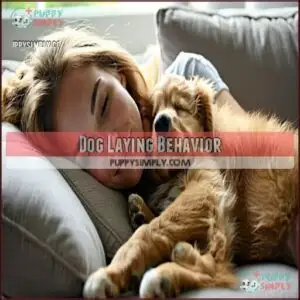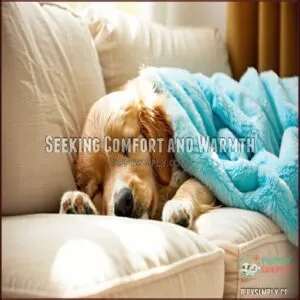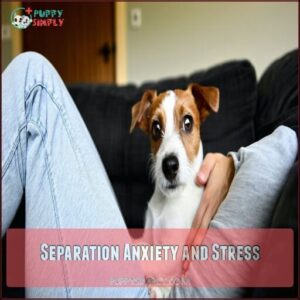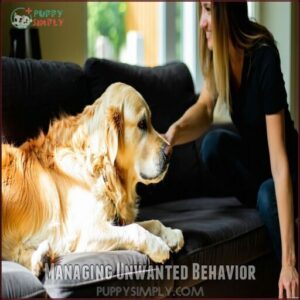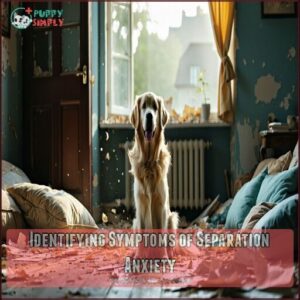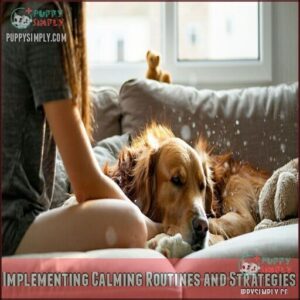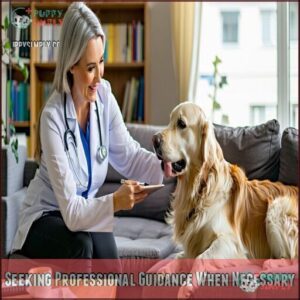This site is supported by our readers. We may earn a commission, at no cost to you, if you purchase through links.

Dogs are pack animals who crave physical closeness – you’re basically their favorite "human mattress" with built-in heating.
When your furry friend sprawls across your lap, they’re showing trust and affection while simultaneously marking you with their scent.
This behavior stems from their wolf ancestors who slept together for warmth and protection.
Your body heat, familiar scent, and steady heartbeat create the perfect relaxation spot for your pup.
Sometimes, they’re simply claiming prime real estate in the house.
Understanding these cuddle sessions can reveal surprising insights about your dog’s emotional needs.
Table Of Contents
- Key Takeaways
- Dog Laying Behavior
- Why Dogs Lay on Owners
- Reasons for Laying
- Benefits of Canine Cuddling
- Managing Unwanted Behavior
- Recognizing Separation Anxiety
- Discouraging Laying Behavior
- Frequently Asked Questions (FAQs)
- Why does my dog lie on Me?
- Why is my dog laying on Me?
- Why do dogs lay on their owners?
- Why do dogs want to lay on top of You?
- Why do dogs love laying on your lap?
- Why do dogs lay on you when you sleep?
- How do you know if your dog is imprinted on you?
- Do dogs lay on their favorite person?
- Why does my dog lay on top of Me?
- Why is my dog laying on my lap?
- Conclusion
Key Takeaways
- Your dog lays on you primarily for comfort and security, seeking your body heat and familiar scent to create their perfect relaxation spot.
- You’re fulfilling your dog’s pack animal instincts when they cuddle with you—they’re showing trust and security while simultaneously marking you with their scent.
- Your dog’s cuddling triggers oxytocin release for both of you, reducing stress and anxiety while strengthening your human-animal bond.
- You’ll need to establish boundaries if this behavior becomes problematic, providing comfortable alternatives and using positive reinforcement to train independence without rejecting their emotional needs.
Dog Laying Behavior
You’ll often find your furry friend sprawled across your lap or chest, a behavior that stems from their deeply rooted pack instincts and desire for connection.
This cuddly habit isn’t just about warmth—it’s your dog’s way of expressing affection, establishing security, and reinforcing that you’re an essential member of their pack, which is a key aspect of their pack instincts.
Pack Mentality and Social Bonding
The age-old pack mentality your furry friend inherited from wolves explains why they’re constantly glued to your lap.
Dogs view you as part of their pack, seeking physical closeness to strengthen your bond.
Dogs also exhibit behaviors like circling before lying down, a trait linked to their ancestral nest-building.
- Ancestral pack bonds drive dogs to huddle with pack members
- Your pup establishes a social hierarchy where you’re the leader
- Canine companionship involves physical touch as communication
- Pack recognition happens through scent and proximity
- Dogs recreate wild huddling behavior for safety and belonging
Affection and Communication
Many dogs express their love by lying directly on you – it’s their way of showing canine affection.
When your furry friend sprawls across your lap, they’re using physical touch as one of their primary dog communication methods.
Certain breeds like Golden Retrievers are especially demonstrative in their dog bonding behavior.
This closeness creates mutual support between you and your pet, strengthening your connection through these simple dog affection signs.
Protection and Security
Every dog carries ancient survival instincts from their wolf ancestors.
When your dog lays on you, they’re creating a safe space while fulfilling their instinctual behavior to protect what they value most.
You’re basically their pack leader – the one who provides security and comfort.
During thunderstorms or fireworks, you’ll notice this protective cuddling intensifies as they seek reassurance from stress.
Your presence offers the same security they once felt with their mother and littermates.
Why Dogs Lay on Owners
Through countless dog years, your furry friend has developed compelling reasons for choosing you as their favorite resting spot.
Dogs instinctively seek closeness with you—their chosen human—for security, affection, and primal connection.
When your dog lays on you, they’re communicating something significant about your relationship.
This canine closeness isn’t just about finding a cozy spot—it’s deeply rooted in your dog’s psychology and evolutionary history.
Your dog might be laying on you for various reasons:
- Security needs drive them to seek physical contact with their trusted human
- Dog comfort seeking behaviors stem from their pack instincts
- Affection expression happens through physical touch and proximity
- Dog showing love by maintaining closeness with their favorite person
- Dominance display can sometimes motivate this behavior in certain contexts
Understanding why your dog seeks this connection helps strengthen your bond.
That warmth you feel when your pup curls up on your lap? It’s mutual—your dog feels it too.
Reasons for Laying
You’ll discover that your dog’s habit of laying on you goes beyond simple comfort seeking and stems from deep-rooted instincts and emotional needs.
From pack mentality inherited from their wolf ancestors to expressing affection and establishing territory, your furry friend’s cuddling behavior communicates volumes about your special bond, highlighting the importance of emotional needs.
Seeking Comfort and Warmth
Your dog’s tendency to lay on you often comes down to basic comfort needs. Dogs are natural warmth-seekers, using thermoregulation to maintain body temperature.
When they curl up with you, they’re tapping into puppyhood memories of huddling with littermates. Your body heat offers both physical warmth and anxiety reduction, especially during bedtime rituals.
Notably, breed differences influence this behavior—Nordic breeds may seek less warmth than short-haired varieties.
Showing Affection and Loyalty
Beyond warmth and comfort, your dog’s snuggle sessions speak volumes about their affection and loyalty.
When your furry friend plops down on your lap or chest, they’re literally showing you they trust you completely.
This canine devotion is their way of expressing love through physical touch.
Some affectionate breeds like Golden Retrievers are particularly fond of this bonding signal, using their bodies to say "I love you" louder than any bark could.
Asserting Dominance or Territorial Behavior
While your pup’s cuddles are sweet, sometimes they’re staking their claim. Your furry friend may be asserting dominance or marking you as their territory when they sprawl across your lap.
Dogs establish hierarchy through physical positioning. When your pooch plants themselves on you, they might be displaying Pack Leader tendencies or engaging in Scent Marking with their paw glands.
Watch for these dominance signals:
- Rolling on your favorite spots after you’ve used them
- Growling if approached while lying on you
- Positioning themselves physically above you whenever possible
Separation Anxiety and Stress
While dominance focuses on control, separation anxiety reveals a deeper emotional struggle.
When you’re away, your furry friend may lay on you to ease their stress.
Dogs with separation anxiety often display destructive behavior when left alone – chewing, howling, or having accidents indoors.
Your scent and presence act as natural calming techniques against anxiety triggers.
If your dog seems unusually clingy, routine changes might help, but persistent dog stress may require professional help.
Benefits of Canine Cuddling
You’ll enjoy more than just warm cuddles when your furry friend sprawls across your lap.
Those cozy moments with your dog actually release mood-boosting hormones that reduce stress and strengthen your bond.
Oxytocin Release and Stress Reduction
When your furry friend snuggles up on your lap, you’re both experiencing a powerful chemical reaction.
Physical contact with your dog triggers oxytocin release, often called the "love hormone," creating a feedback loop of positive feelings.
- Your stress hormones decrease while happiness chemicals increase
- Both you and your dog enjoy mutual well-being benefits
- Canine companionship provides natural anxiety relief without medication
- Even brief petting sessions boost mood through bonding neurochemistry
This interaction results in a win-win situation, where mutual well-being is enhanced for both you and your dog.
Improved Sleep and Reduced Anxiety
Throughout the night, sleeping with your dog can dramatically improve your own sleep quality.
The rhythmic sound of your dog’s breathing works as a natural relaxant, helping ease anxiety-induced insomnia. Your dog’s warmth and presence provide canine comfort that reduces stress hormones and promotes deeper sleep.
This mutual benefit extends to your pup too – dogs experience less anxiety when sleeping near their owners, enhancing overall wellbeing for both of you, with canine comfort and natural relaxant being key to this mutual benefit.
Strengthened Human-Animal Bond
When your dog lays on you, it’s building a bridge of trust that strengthens your bond.
A dog sprawled across your lap isn’t just seeking warmth—they’re weaving invisible threads of trust between your hearts.
This mutual affection creates a connection that goes beyond basic companionship. Studies show these shared experiences release oxytocin in both you and your pet, cementing your relationship.
Your dog’s physical closeness also provides emotional support, creating a two-way street of comfort that deepens your dog-human bond over time.
This behavior also reflects their need for social bonds, which is a key aspect of their nature, highlighting the importance of mutual affection and emotional support.
Managing Unwanted Behavior
If your furry friend’s constant need to be your personal blanket is becoming a problem, you’ll need to establish clear boundaries while still meeting their emotional needs.
You can redirect this behavior by providing comfortable alternatives and using consistent training techniques that reward independence without making your dog feel rejected, which helps in setting boundaries.
Providing Comfortable Alternatives
While canine cuddling offers emotional benefits, you’ll need comfy alternatives when your dog’s constant lying becomes problematic.
Creating designated spaces with cozy dog beds gives your pup their own territory. Try placing these beds near you with something carrying your scent.
For comfortable rest, consider various supportive options. Add calming music and interactive toys to encourage independent play.
Well-defined boundaries help establish healthy dog sleeping arrangements without sacrificing the connection you both cherish.
Positive Reinforcement Training
Now that you’ve set up a cozy spot for your pup, it’s time to teach them to use it.
Positive reinforcement works wonders in shaping behavior without creating stress. When your dog chooses their bed over your lap, reward them with treats, verbal praise, or a quick click from a training clicker.
Remember to ignore negativity—don’t scold when they jump on you, but lavish attention when they make the right choice.
This approach aligns with operant conditioning fundamentals, where actions have consequences and positive reinforcement is key to successful training, using methods like verbal praise and a training clicker.
Addressing Underlying Anxiety
When your furry friend won’t stop laying on you, three underlying anxiety issues might be at play.
First, identify anxiety triggers like loud noises or visitors.
Create a secure environment with consistent routines and calming techniques such as pressure wraps or pheromone diffusers.
For severe cases, don’t hesitate to seek professional help—veterinary behaviorists can offer customized dog anxiety relief strategies that address the root causes, not just the symptoms, and provide anxiety relief.
Recognizing Separation Anxiety
You’ll often notice your dog won’t leave your side and frantically follows you from room to room when they’re struggling with separation anxiety.
This clingy behavior, where they insist on laying directly on top of you, serves as their way of preventing you from leaving again, much like a furry paperweight keeping you firmly in place.
Identifying Symptoms of Separation Anxiety
In the aftermath of your departure, your dog’s destructive behavior might be telling you something important.
Watch for excessive vocalization, inappropriate elimination in house-trained pets, and constant pacing/restlessness.
These classic dog separation anxiety symptoms can escalate to escape attempts when left alone.
Your once-calm companion might suddenly become a tornado of canine anxiety—chewing furniture, howling non-stop, or clawing at doors when you’re gone.
Addressing these issues often requires behavior modification and training, which can help alleviate dog separation anxiety and improve your pet’s overall well-being, by implementing effective behavior modification techniques and providing proper training.
Implementing Calming Routines and Strategies
Now that you’ve identified separation anxiety symptoms in your pup, it’s time to create a calming environment.
Implementing consistent routines reduces dog anxiety dramatically.
You’ll see improvement with these anxiety reduction strategies:
- Set a rock-solid daily schedule – feed, walk, and play at the same times
- Create a safe retreat – comfortable bed with your worn clothing
- Provide environmental enrichment – puzzle toys and calming music when you’re gone
Consider providing stimulating dog toys to keep them occupied.
Establish clear dog boundaries and gradually increase alone time to build confidence.
Seeking Professional Guidance When Necessary
When your dog’s laying behavior becomes excessive or concerning, reach out for professional help.
Some dog anxiety signs, like extreme clinginess or destructiveness, indicate deeper issues beyond basic training limitations.
A veterinary behaviorist can rule out medical causes and develop targeted anxiety management strategies.
If you notice behavioral red flags or aggression concerns, don’t hesitate to consult your vet—they’ll guide you through appropriate dog behavior modification techniques to address deeper issues.
Discouraging Laying Behavior
While you might love your furry friend’s cuddles, sometimes you’ll need to discourage excessive laying behavior when it interferes with daily activities or reinforces anxiety.
You can establish healthy boundaries through consistent training with commands like "off" and by rewarding your dog for using their own bed, ensuring both of you maintain a balanced relationship.
Signs of Possessiveness or Aggression
While separation anxiety makes your dog stick to you, sometimes laying behavior signals something more concerning.
Watch for resource guarding when your dog growls if you approach while they’re on you. Body language like raised hackles, staring, or standing over you can indicate possessiveness.
If your pup snaps when others come near while they’re laying on you, they’re exhibiting aggression. These dog dominance behaviors require consistent training methods or professional help.
Dogs that exhibit these behaviors may be showing signs of possessive aggression.
Discomfort or Interference With Daily Life
While possessive behaviors require firm boundaries, your furry friend’s constant cuddling might also create practical problems.
When your dog laying on me becomes a daily struggle, it can lead to limited mobility, sleep disruption, and even social isolation.
You can’t move, work, or welcome guests when your 70-pound buddy claims your lap as their throne.
Establishing personal space isn’t selfish—it’s necessary for your quality of life.
Exacerbating Separation Anxiety
Counterintuitively, constant cuddling can worsen your pup’s separation anxiety rather than soothe it.
When you allow excessive laying behaviors, you’re unintentionally reinforcing their dependence.
Here’s how constant cuddling backfires:
- Creates panic when you’re unavailable
- Prevents development of coping skills
- Reinforces anxious behaviors
- Establishes unhealthy attachment patterns
Instead, balance affection with teaching independence through consistent training and gradually increasing alone time to promote healthy attachment.
Frequently Asked Questions (FAQs)
Why does my dog lie on Me?
Your furry friend lies on you to share warmth, show affection, and establish security.
They’re seeking closeness from their pack leader while expressing love and trust through physical contact.
It’s instinctual canine behavior.
Why is my dog laying on Me?
Your dog sees you as part of their pack, craving warmth and showing affection.
They’re also marking you with their scent, seeking security, and sometimes asserting dominance.
It’s their way of bonding with you, which can be seen as a form of pack behavior.
Why do dogs lay on their owners?
Nearly 80% of dogs display pack-bonding behaviors inherited from wolves.
Your canine companion lies on you to express affection, seek security, mark territory, and reinforce their bond with you as part of their pack.
Why do dogs want to lay on top of You?
Your furry companion sees you as part of their pack, seeking warmth, security, and connection when they cuddle up on top of you.
It’s their way of showing affection and strengthening your bond.
Why do dogs love laying on your lap?
Like puzzle pieces finding their perfect fit, dogs love laying on your lap for warmth, security, and affection.
It’s their way of bonding with you while feeling safe in your trusted presence.
Why do dogs lay on you when you sleep?
When you’re sleeping, your furry friend may curl up on you for warmth, security, and to strengthen your bond.
They’re following pack instincts that drive them to stay close to family during vulnerable moments.
How do you know if your dog is imprinted on you?
You’ll notice your dog is imprinted on you when they follow you everywhere, make consistent eye contact, get excited at your return, and seek your comfort during stressful situations.
Do dogs lay on their favorite person?
Dogs often choose their favorite person as a living pillow, showing trust and affection. They’re seeking warmth, protection, and bonding time with the human they’ve chosen as their special someone.
Why does my dog lay on top of Me?
Your dog lays on you to show affection, seek warmth, assert dominance, mark you as territory, or strengthen your pack bond.
It’s their way of saying "you’re mine" while feeling secure.
Why is my dog laying on my lap?
Your furry friend chooses your lap as their favorite spot because they’re seeking warmth, showing affection, and reinforcing your bond.
They view you as part of their pack and feel safe with you.
Conclusion
Every cloud has a silver lining when your dog chooses you as their favorite resting spot.
Whether your furry friend lays on you for warmth, security, or simply to strengthen your bond, these cuddle sessions reveal deep trust and affection.
By understanding why your dog lays on you, you’ll gain insights into their emotional needs and communication style.
Embrace these moments – they’re your dog’s way of saying you’re their safe haven and best friend.
- https://vcahospitals.com/know-your-pet/dog-behavior-and-training-dominance-alpha-and-pack-leadership-what-does-it-really-mean
- https://www.sleepfoundation.org/animals-and-sleep/sleeping-with-pets
- https://news.vet.tufts.edu/author/sborns01/
- https://www.healthline.com/health-news/dogs-mirror-owners-stress
- https://www.medicalnewstoday.com/articles/320170

